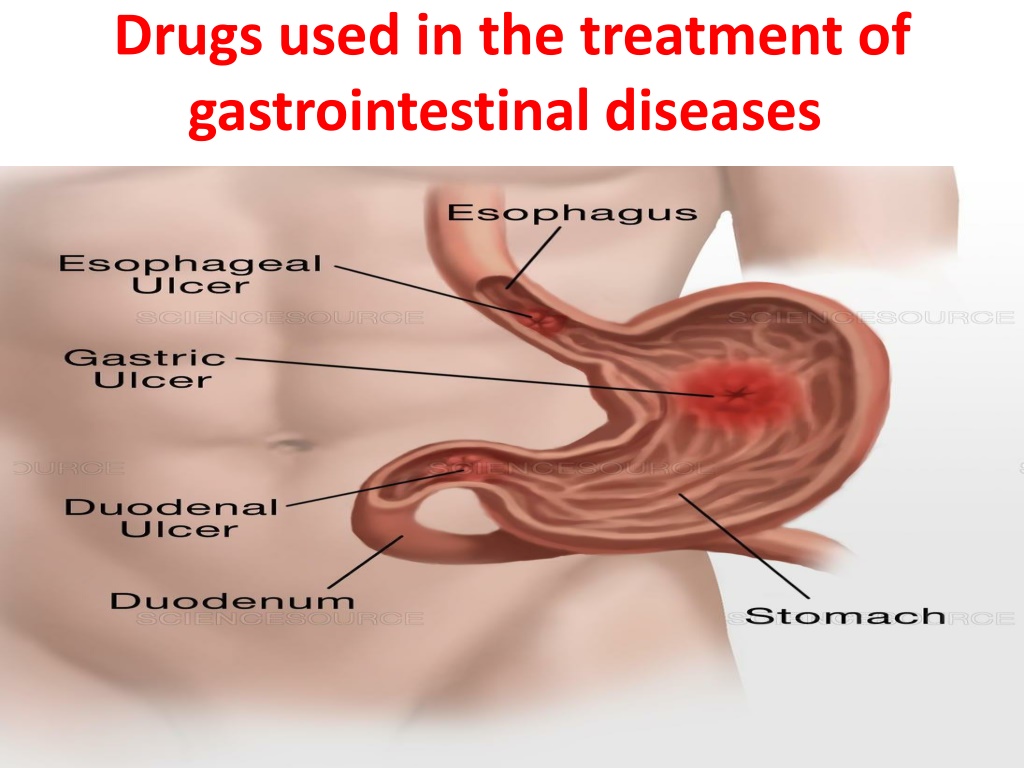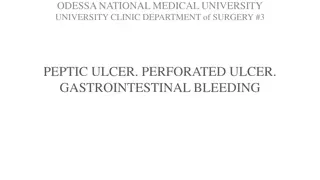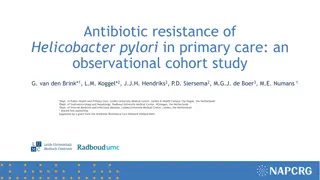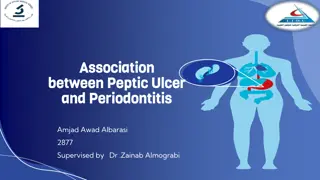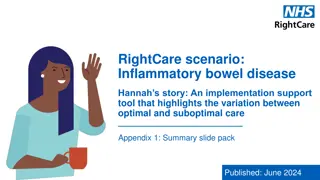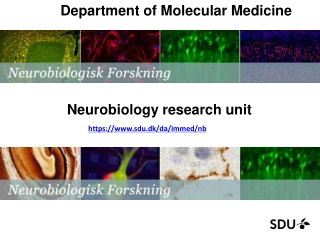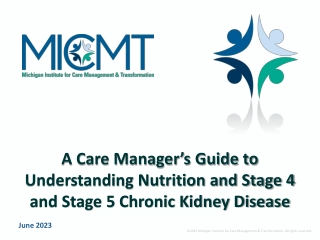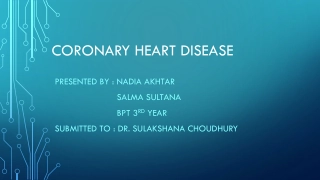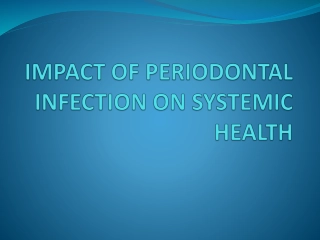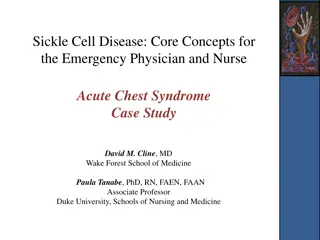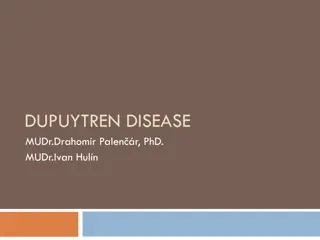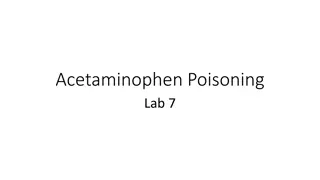Peptic Ulcer Disease: Treatment Approaches and Helicobacter pylori Eradication
Common gastrointestinal conditions such as peptic ulcers can be effectively treated through approaches like eradicating H. pylori infection, reducing gastric acid secretion, and using mucosal protecting agents. Helicobacter pylori eradication is crucial for healing ulcers and preventing recurrence, with triple and quadruple therapy being preferred options based on antibiotic resistance patterns. Single antimicrobial therapy is not recommended due to lower efficacy and potential for resistance. Gastroesophageal reflux disease (GERD) is a separate condition not linked to H. pylori. Treatment decisions should ideally consider antibiotic susceptibility testing for optimal outcomes.
Download Presentation
Please find below an Image/Link to download the presentation.
The content on the website is provided AS IS for your information and personal use only. It may not be sold, licensed, or shared on other websites without obtaining consent from the author. Download presentation by click this link. If you encounter any issues during the download, it is possible that the publisher has removed the file from their server.
- Peptic Ulcer Disease
- Helicobacter pylori
- Treatment Approaches
- Antibiotic Therapy
- Gastrointestinal Conditions
Presentation Transcript
Drugs used in the treatment of gastrointestinal diseases
Common gastrointestinal conditions: 1. Peptic ulcers 2. Gastroesophageal reflux disease (GERD) 3. Vomiting 4. Diarrhea 5. Constipation 6. Irritable bowel syndrome (IBS) 7. Inflammatory bowel disease (IBD)
Peptic ulcers Two main causes of peptic ulcer disease: 1. Infection with G-ve Helicobacter pylori 2. NSAIDs Increased acid (HCl) secretion & inadequate mucosal defense also play a role
Treatment approaches 1. Eradication of H. pylori infection 2. Reducing secretion of gastric acid: proton pump inhibitors or H2- receptor antagonists 3. Mucosal protecting agents: Sucralfate
1. Helicobacter pylori eradication Colonization of the stomach and duodenum occurs in almost all patients with duodenal ulcer and in the majority of patients with gastric ulcer. Chronic infection with H pylori is present in most patients with recurrent non-NSAID- induced peptic ulcers. Eradication of H. pylori results in rapid healing of active ulcers & low recurrence rates.
Triple therapy Is a preferred therapy when rates of clarithromycin resistance are low & low prior exposure to macrolides. It is consist of a PPI (omeprazole) combined with amoxicillin ( or metronidazole if penicillin-allergic) plus clarithromycin.
Quadruple therapy Bismuth subsalicylate, metronidazole, & tetracycline plus a PPI. Quadruple therapy is considered in areas of clarithromycin resistance. Recently, quaruple therapy is a recommended first line option. Results in 90% eradication. *Rifabutin-based regimen contains omeprazole, rifabutin, and amoxicillin. Rifabutin-resistant strains are rare.
Notes: Single antimicrobial is not recommended: less effective & results in resistance Do not substitute ampicillin for amoxicillin or doxycycline for tetracycline GERD (heartburn) is not associated with H. pylori. Ideally, the optimal regimen would be determined by antibiotic susceptibility testing; however, this requires endoscopic biopsy. Confirm successful eradication of H pylori with urea breath test, fecal antigen test, or endoscopy with biopsy at least 4 weeks after completion
) ( Active Helicobacter pylori associated ulcer: 1. Treat with anti H pylori regimen for 14 days. Best empiric treatment options: Standad Bismut Quadruple Terapy PPI orally twice daily Bismuth subsalicylate 262 mg two tablets orally four times daily or bismuth subcitrate 120 400 mg orally four times daily Tetracycline 500 mg orally four times daily Metronidazole 500 mg three times daily OR PPI orally twice daily1 Bismuth subcitrate potassium 140 mg/metronidazole 125 mg/tetracycline 125 mg (Pylera) three capsules orally four times daily 2. Rifabutin-Based Triple Therapy (Talicia) four capsules, each capsule contains omeprazole 10 mg/rifabutin 12.5 mg/amoxicillin 250 mg, orally every 8 hours, thus total dosages are Omeprazole 40 mg orally every 8 hours Rifabutin 50 mg orally every 8 hours Amoxicillin 1000 mg orally every 8 hours 3. Standard Triple Terapy (No longer recommended except in locales where clarithromycin resistance is < 15%) PPI orally twice daily Clarithromycin 500 mg orally twice daily Amoxicillin 1 g orally twice daily (or, if penicillin allergic, metronidazole 500 mg orally twice daily) 4. After completion of course of H pylori eradication therapy, continue treatment with PPI1 once daily for 4 6 weeks if ulcer is large (> 1 cm) or complicated.
H2-receptors antagonists: Cimetidine , Ranitidine They act by blocking H2-receptors in the parietal cells in the stomach and therefore inhibit acid secretion. No effect on H1receptors They reduce the volume of acid secretion and also increase the PH of the acid (make the lumen of the stomach more alkaline), They relief symptoms and promote healing in peptic ulcer
Clinical uses: 1. peptic ulcer: as they promote healing of peptic ulcer and reduce relapse rate 2. reflux esophagitis (GERD, heartburn) 3. Acute stress ulcers
Adverse effects 1. Diarrhea and skin rash, mental confusion in elderly 2. Gynaecomastia & galactorea due to anti- androgen effect of cimetidine 3. Cimetidine is an enzyme inhibitor reversibly inhibits cytochrome P450. This inhibits the metabolism of drugs as warfarin, phenytoin, propranolol, metoprolol, and theophylline.
Pharmacokinetics Cimetidine: is well absorbed when given orally, half-life about 2 hours. Partly metabolized in the liver but mainly excreted unchanged by the kidney. The half-life increase up to 5 hours in case of renal failure Ranitidine: less enzyme inhibitor than cimetidine, and fewer incidences of adverse effects
Proton Pump Inhibitors: Omeprazole, Lansoprazole Irreversibly inhibits H+/K+ ATPase enzyme, which effectively stops the proton pump and thus prevents the formation of gastric acid. It is the most effective agent in severe cases of ulceration and esophageal reflux They are more potent than all the other antiulcer drugs, as they inhibit the final common step in acid secretion. They also promote healing of the ulcer
Omeprazole: Omeprazole is a pro-drug , enters the parietal cell from the blood by non-ionic diffusion. It is given orally, and because of its degradation by the acidic medium in the stomach it is given in enteric coated tablet. It is used in peptic ulcer, GERD, stress ulcers and Zollinger-Ellison syndrome (gastrin secreting tumor of the pancreas)
Adverse effects of omeprazole: 1. Nausea, headache, diarrhea and clostridium difficile colitis 2. Omeprazole is an enzyme inhibitor, decreasing the metabolism of warfarin, phenytoin, carbamazepine and diazepam. 3. Omeprazole decreases clopidogrel efficacy by inhibiting the conversion to its active form. 4. Chronic hypochlorhydria also decrease the absorption of vitamin B12 which leads to megaloblastic anemia
MCQ A 45-year-old man with a duodenal ulcer was treated with a combination of drugs to heal the mucosal damage and to eradicate H. pylori. Which of the following drugs is commonly used? a. Cefazolin b. Ciprofloxacin c. Clarithromycin d. Clindamycin e. Vancomycin
MCQ In H. pylori eradication, A. It is necessary for GERD management. B. Bismuth chelate helps in the eradication of H. pylori C. Clarithromycin is part of quadruple therapy D. Amoxicillin can be substituted by ampicillin E. Triple therapy for H. pylori eradication include omeprazole + Gentamicin + amoxicillin
MCQ The primary pharmacologic action of omeprazole is the reduction of a. Volume of gastric juice b. Gastric motility c. Secretion of pepsin d. Secretion of gastric acid e. Secretion of intrinsic factor
MCQ Omeprazole, an agent for the promotion of healing of peptic ulcers, has a mechanism of action that is based on a. Prostaglandins b. Gastric secretion c. Pepsin secretion d. H+/K+ ATPase e. Anticholinergic action
MCQ The preferred drug therapy for Zollinger- Ellison syndrome is a. Ranitidine b. Ca carbonate c. Omeprazole d. Sucralfate e. Misoprostol
MCQ A 40-year-old male came to the emergency department with severe burning chest pain radiating into his neck. A diagnosis of GERD was made and he was sent home with a prescription for a drug that inhibits acid. Which of the following is a drug of choice? (A) Cimetidine (B) Misoprostol (C) Omeprazole (D) Metoclopramide (E) Sulfasalazine
MCQ A male patient with duodenal ulcer on antiulcer drugs developed tender enlargement of breasts. Which one of the following drugs is most likely responsible of this effect? a. Omeprazole b. Ranitidine c. Aluminum salts d. Cimetidine e. Sucralfate
MCQ Cimetidine slows the metabolism of many drugs because it inhibits the activity of a. Monoamine oxidase (MAO) b. Cytochrome P450 c. Tyrosine kinase d. Hydrogen potassium adenosine triphosphatase (H+/K+,ATPase) e. Phase II glucuronidation reaction
